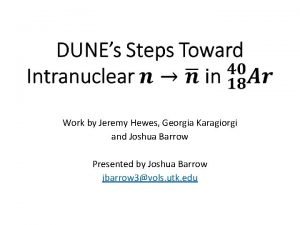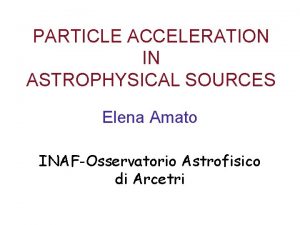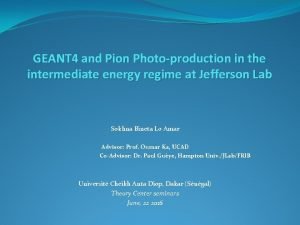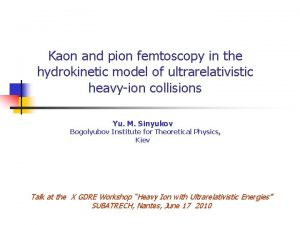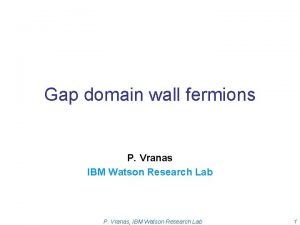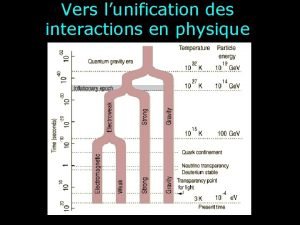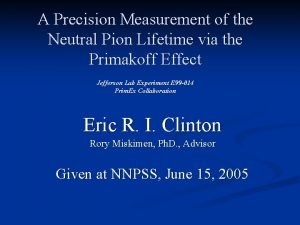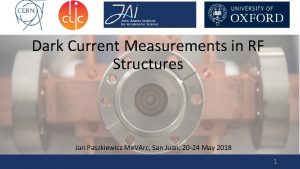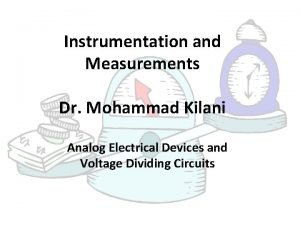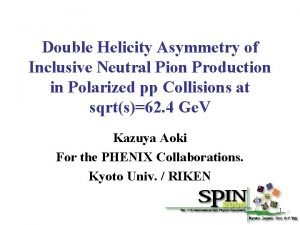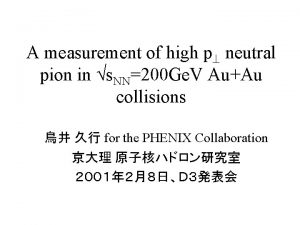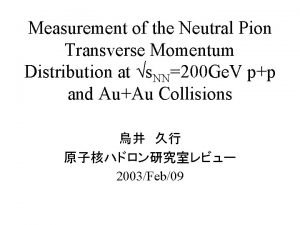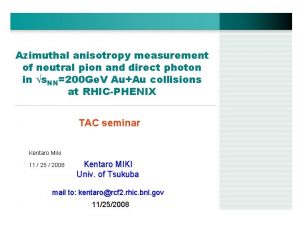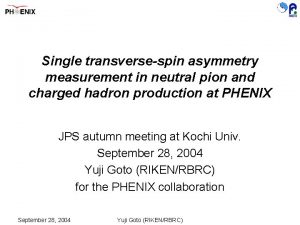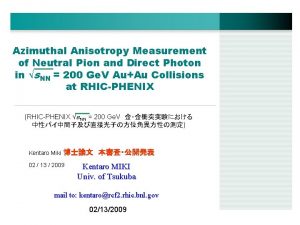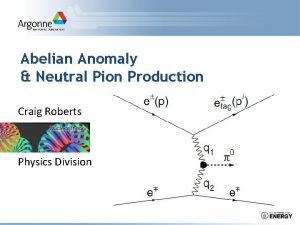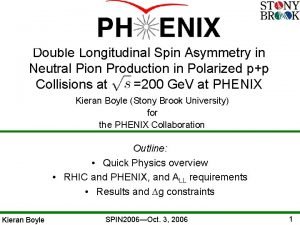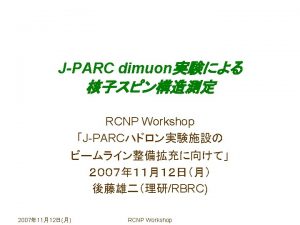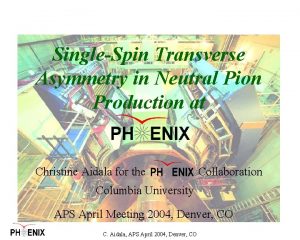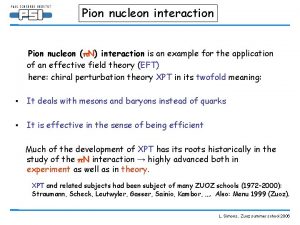Measurement of Inclusive Neutral Current Neutral Pion Production





















- Slides: 21

Measurement of Inclusive Neutral Current Neutral Pion Production on Carbon in a Few-Ge. V Neutrino Beam ar. Xiv: 0910. 5768 [hep-ex] K. Hiraide November 5 th, 2009 ICRR colloquium 1

Contents • Sci. Boo. NE experiment • Analysis and results – Measurement of s(NC-p 0)/s(CC) ratio – NC coherent pion production • Summary 2

Sci. Boo. NE experiment (FNAL E 954) Booster Neutrino Beam • Precise measurements of neutrino- and antineutrino-nucleus cross sections near 1 Ge. V • Essential for future neutrino oscillation experiments • Neutrino energy spectrum measurements • Mini. Boo. NE/Sci. Boo. NE joint disappearance • e constraint for Mini. Boo. NE 3

Booster Proton accelerator • 8 Ge. V protons sent to target Target Hall • Beryllium target: 71 cm long 1 cm diameter • Resultant mesons focused with magnetic horn To Mini. Boo. NE Sci. Boo. NE • Reversible horn polarity 50 m decay volume • Mesons decay to & • Short decay pipe minimizes edecay Sci. Boo. NE located 100 m from the beryllium target Sci. Boo. NE 4

Booster Neutrino Beam (BNB) Expected neutrino flux at Sci. Boo. NE (neutrino mode) • mean neutrino energy ~0. 7 Ge. V • 93% pure beam • anti- (6. 4%) • e + anti- e (0. 6%) • antineutrino beam is obtained by reversing horn polarity 5

Sci. Boo. NE detector Muon Range Detector (MRD) Sci. Bar • scintillator tracking detector • 14, 336 scintillator bars (15 tons) • Neutrino target • detect all charged particles • p/p separation using d. E/dx Used in K 2 K experiment • 12 2”-thick steel + scintillator planes • measure muon momentum with range up to 1. 2 Ge. V/c n Parts recycled from Past experiment at FNAL Electron Catcher (EC) 4 m 2 m • spaghetti calorimeter • 2 planes (11 X 0) • identify p 0 and e Used in CHORUS, HARP and K 2 K 6

Sci. Boo. NE data-taking Number of Protons on target (POT) • Jun. 2007 – Aug. 2008 • 95% data efficiency • 2. 52 x 1020 POT in total • neutrino : 0. 99 x 1020 POT • antineutrino: 1. 53 x 1020 POT 7

Neutral current p 0 production 8

NC inclusive p 0 at Sci. Boo. NE NC neutrino interaction in which at least one p 0 is emitted in the final state from the target nucleus 9

Event selection 1. Pre-selection cuts • At least two tracks • 1 st layer veto 2. Muon track rejection cuts 3. Track disconnection cut 4. Electron catcher cut 5. Number of photon tracks 6. Reconstructed p 0 vertex cut 7. Reconstructed p 0 mass cut 10

CC event rejection in Sci. Bar Muon track rejection using decay electron p, p CC event Track disconnection cut 11

CC event rejection using EC Events are selected if one of the following condition are satisfied: 1. No matched EC cluster 2. E 1>150 Me. V 3. REC=E 2/E 1<0. 2 E 1 E 2 Sci. Bar EC 12

“Extended” track ( photon track candidate) Requiring non-proton like Merging two or more tracks If they are nearly co-linear Muon Confidence Level (Mu. CL) Particle ID variable based on d. E/dx 13

Dirt background rejection Vertex resolution ~12 cm 14

Reconstructed p 0 mass 50 Me. V/c 2<Mp 0<200 Me. V/c 2 • 657 events are selected after all cuts • 240 BG events expected • Selection efficiency: 5. 3% 15

CC inclusive event sample (for normalization) MRD-stopped Sci. Bar EC MRD muon • Muon is identified using MRD • The track should start from Sci. Bar fiducial volume • Muon stops in MRD 16

s(NC-p 0)/s(CC) cross section ratio 17

Reconstructed p 0 kinematics 18

Corrected p 0 kinematics • Subtract the expected BG • Convert the reconstructed momentum (angle) to the true ones using unfolding method • Perform the efficiency correction 19

NC coherent pion extraction Fit Ep(1 -cos qp) distribution with two fitting parameters Rcoh: NC coherent p scaling Rres: NC resonant p scaling 20

Summary • Sci. Boo. NE has measured NC p 0 production on polystyrene target. • s(NC-p 0)/s(CC)=(7. 7+/-0. 5(stat. )+/-0. 5(sys))x 10 -2 at mean neutrino energy 1. 1 Ge. V. • The measured shapes of the p 0 momentum and angular distributions agree with the MC prediction based on the Rein. Sehgal model. • s(NC-coherent p 0)/s(CC)=(0. 9+/-0. 5)x 10 -2 • This result is consistent with the Rein-Sehgal model. • Submitted to Phys. Rev. D 21
 Alir produksi multimedia
Alir produksi multimedia Georgia karagiorgi
Georgia karagiorgi Pion decay
Pion decay Pion geant
Pion geant Pion
Pion Pion diamonds
Pion diamonds Louis pion montre
Louis pion montre Pion lifetime
Pion lifetime Dark current measurement
Dark current measurement Ballast circuit strain gauge
Ballast circuit strain gauge The value of vgs that makes is approximately zero
The value of vgs that makes is approximately zero Welding chapter 3
Welding chapter 3 Drift current and diffusion current in semiconductor
Drift current and diffusion current in semiconductor In a y-connected source feeding a ∆-connected load,
In a y-connected source feeding a ∆-connected load, Touch current vs leakage current
Touch current vs leakage current Ac systems lesson 4
Ac systems lesson 4 Slideplayer
Slideplayer Y connected generator
Y connected generator Non planar circuit
Non planar circuit Ceramic composition resistors
Ceramic composition resistors Drift current and diffusion current in semiconductor
Drift current and diffusion current in semiconductor Drift current density unit
Drift current density unit

